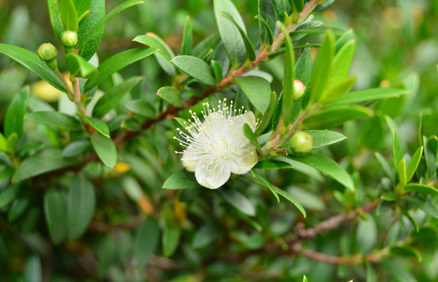Arba minim from the Land of Israel

While the mitzvah of taking the arba minim is not a land-dependent mitzvah, it nevertheless is linked to the Land of Israel. A few words on these four species and their connection to the Holy Land.
The mitzvah of taking arba minim, the four species, is not a land-dependent mitzvah; rather it is to be observed all over the world. Nevertheless, the Torah links the mitzvah of Sukkot to the Land of Israel:
Mark, on the fifteenth day of the seventh month, when you have gathered in the yield of your land, you shall observe the festival of the L-rd seven days: a complete rest on the first day, and a complete rest on the eighth day. On the first day you shall take the fruit of a magnificent tree, branches of palm trees, boughs of leafy trees, and willows of the brook, and you shall rejoice before the L-rd your G-d seven days. (Vayikra 23:39–40)
Sukkot is a holiday celebrated when fruit is harvested. Even when leap years were instituted, the beit din had to ensure that Sukkot would fall out during harvest: "'When you gather in the yield of your land.' How so? Take care to intercalate the year so that the holiday [of Sukkot] will fall out at the time most of the fruits are harvested" (Sifra Emor, §12:15).
Rambam writes that taking these species is an expression of thanksgiving and joy for G-d taking us out of the desert and entering the Land of Israel:
I believe that the four species are a symbolical expression of our rejoicing that the Israelites changed the wilderness, "no place of seed, or of figs, or of vines, or of pomegranates, or of water to drink" (Bamidbar 20:5), with a country full of fruit trees and rivers. In order to remember this, we take the fruit which is the most pleasant of the fruit of the land, the best-smelling branches, most beautiful leaves, and also the best of grasses, i.e., the willows of the brook. (Guide for the Perplexed 3:43, Friedlander trans.)
"The most pleasant of the fruit of the land" – date palm, from which we take the lulav; "the best-smelling [fruit]–etrog; "most beautiful leaves"–hadas; and "the best of grasses"–the arava. These four species are manifestations of the good, the beautiful, and pleasant-smelling of fruit in general, which had not been available to them in the wilderness.
Why did the Torah command that we take specifically these species, and not of the seven species—pomegranates, grapes, or figs—which the Israelites lacked in the desert, as they complained before Moshe ["And neither did you take us to a place flowing with honey, pomegranates –fill in rest"]? The Rambam provides three reasons why these species specifically were chosen, and not others:
These four kinds have also those three purposes: (1) First, they were plentiful in those days in the Land of Israel, so everyone could easily find them. (2) Secondly, they have a pleasant appearance and are green, and some of them are also of an excellent smell, viz. the citron and myrtle; but the branches of the palm tree and willow have neither a good or bad smell. (3) Thirdly, they keep fresh and green for seven days, which is not the case with peaches, pomegranates, asparagus, nuts, and the like (ibid.).
The four species grow now, as well, in the Land of Israel. At Sukkot time, they are also green and at the height of bloom, also keeping for the entire duration of the festival.
As stated above, the obligation to take the arba minim is not included in the land-dependent mitzvot. However, since they are certainly connected to the flora of the Land of Israel, this mitzvah acts as the link between land-dependent and non-land dependent mitzvot. As Rabbi Avraham Yitzchak HaKohen Kook explains (Orot HaRe'aya, Yerach Eitanim, p. 299):
These are mitzvot which are the obligation of the person, but are also linked to the Land of Israel in their overt character. It is in these mitzvot that two forces converge: the force of the land-dependent mitzvah and the force of the mitzvot dependent on the person. … The nation senses this double relationship—of the sanctity of the Land and the sanctity of the person—hinged on this precious mitzvah! The People of Israel, although not prophets, are nevertheless the sons of prophets (Pesachim 66b); they perceive the tremendous light of the inner sanctity of their souls, and are enthused together with this precious mitzvah, which contains the sanctity of Land and body—and perform it with joy and exceeding splendor.
Among these unique species grown in Israel are the palms which provide sechach, lulavim, and dates. The lulavim that would grow in Gush Katif are considered the highest quality variety (El Arish). During the Sukkot, these palms would be laden with especially delicious, luscious dates. This also was a sign that the Land of Israel gave its fruits bountifully. It is with good reason that two settlements of Gush Katif were linked with the date palm: Neve Dekalim means "home of palms" and Gadid means "date harvest." May we merit to use the lulavim of Gush Katif once again, with its rebuilding speedily and in our days.




